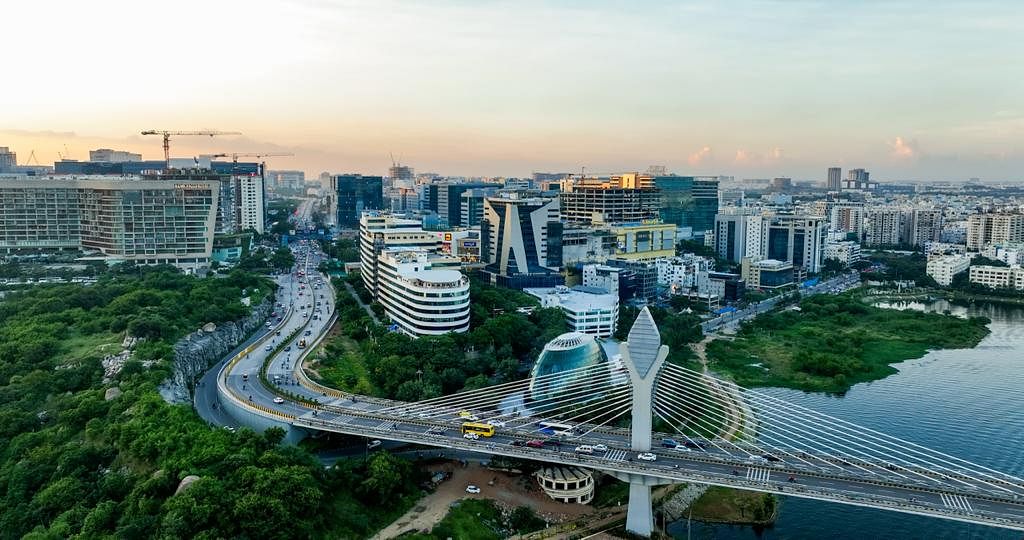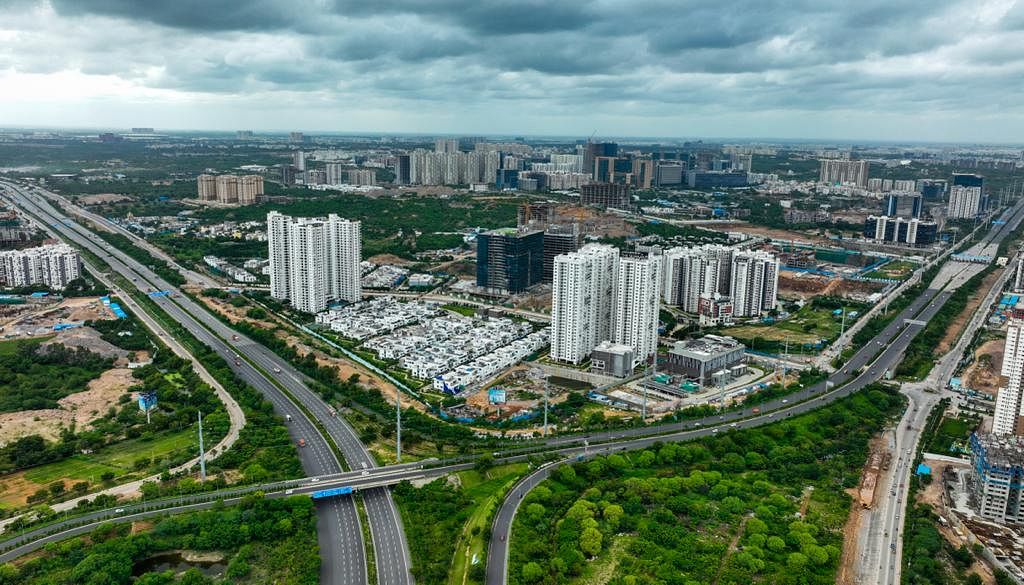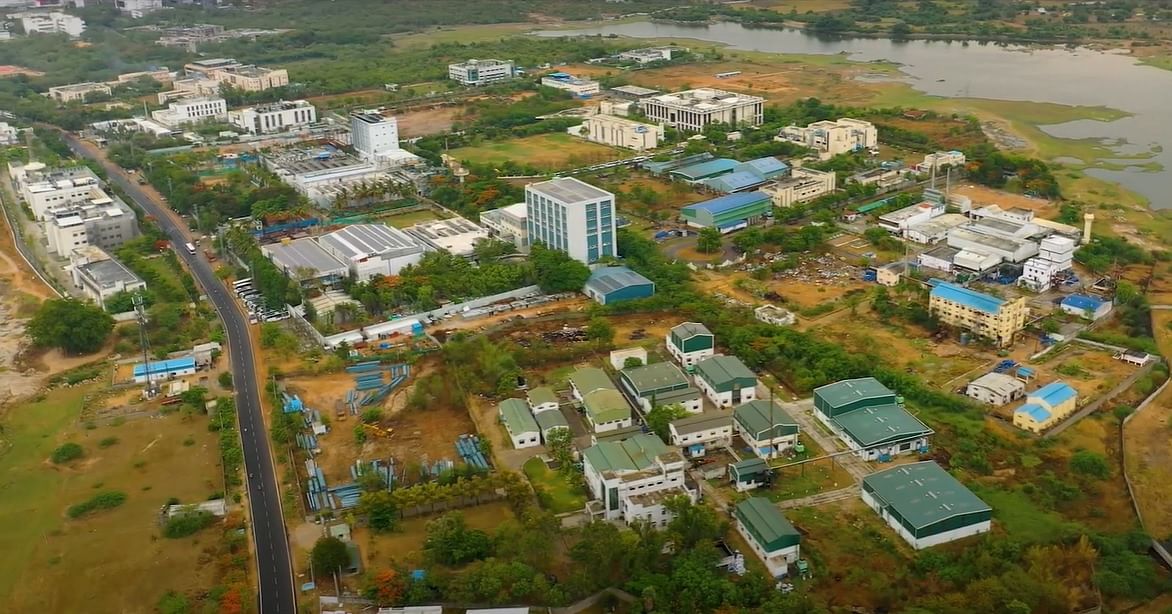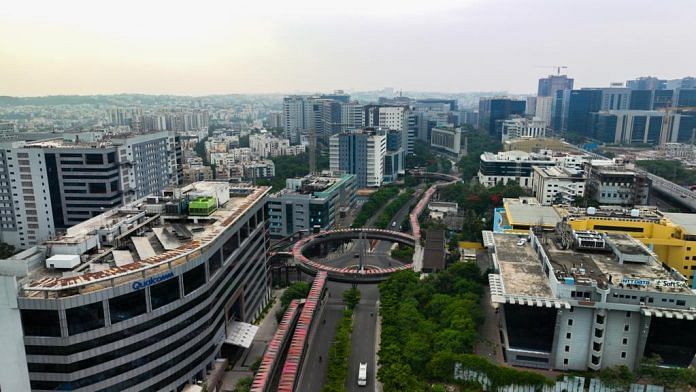Hyderabad: When Kaynes Technologies, a Karnataka-based integrated electronics manufacturing player with presence in seven cities, was hunting for sites to set up a new semiconductor assembly and test plant, it didn’t have to look very far.
Hyderabad, in neighbouring Telangana, ticked all the boxes and the company broke ground for its facility there last month.
Speaking to ThePrint, Kaynes SemiCon CEO Raghu Panicker said it was not only because their customers are based in and around Hyderabad that made it the clear choice. “It’s the ecosystem,” he added. “The speed at which Telangana is working, the quick approvals and clearances, was impressive.”
There’s nothing new about Hyderabad’s credentials as an industry hub. Chandrababu Naidu, in his stint as chief minister of united Andhra Pradesh, is credited for developing Cyberabad as India’s next big IT hub after Bengaluru.
Many major PSUs — be it in pharma (Indian Drugs and Pharmaceuticals Limited, which has since shut down) or defence (DRDO, Bharat Dynamics Limited) — were historically based out of present-day Telangana, and their presence had resulted in many ancillary units coming up in and around Hyderabad and the neighbouring Rangareddy district.
But industry analysts and government officials say the traction that the sectors got waned over a period of time, until Telangana became a state of its own, carved out of Andhra Pradesh, in 2014.
Its industry-friendly policy initiatives, they add, have brought investors back.
With big global and domestic names — from the services sector to pharma, defence and aerospace to electronics, textile and food processing — setting up shop here, India’s youngest state is flourishing.
According to the Telangana government’s Socio-Economic Outlook 2023, the state’s GSDP at current prices shot up to Rs 13.27 lakh crore in 2022-23 (provisional estimate), from Rs 5.06 lakh crore in 2014-15.
Telangana accounts for 5 percent of India’s GDP.
Telangana’s growth is mostly driven by the services sector (62.8 percent) followed by the manufacturing sector (19 percent) and agriculture and allied sectors (18.2 percent).
Since 2014, the per capita income of the state has increased by 156 percent. At Rs 3.17 lakh, Telangana had the third highest per capita income in India in 2022-23, after Sikkim and Goa, which are much smaller in size. The national per capita income was Rs 1.70 lakh in 2022-23.
According to Madan Pillutla, Dean of the premier Hyderabad-based Indian School of Business, the two main factors that have propelled the Telangana growth story are the large industrial base it has had since before bifurcation, and the thriving education sector comprising a good number of technical and engineering institutions in Hyderabad.
These, he said, are the natural advantages that Hyderabad has when it comes to retaining companies that require skilled manpower. “The IT and pharma sector have immensely benefited from this,” he added.
“What has also helped the state in retaining big-ticket companies is the focus and clarity in the government as far as its industrial policy is concerned,” he said. “Another factor is the continuity in policy in the last 20 years. Hyderabad and Telangana benefitted from policy continuity. Stability in the policy regime attracts investment.”
Even so, Telangana’s growth is not without its challenges — one of the primary issues being that the Hyderabad boom is said to have left the vast majority of the state’s districts untouched, and calls have been made for the government to shift its focus to tier-2 and tier-3 cities as well.
The government says efforts on this count are already well underway.
Lockheed Martin to Safran: ‘Repeat investments’
US global security and aerospace major Lockheed Martin was already manufacturing the empennage (tail section) of the military helicopter C-130 at its Hyderabad facility, when it green-lit two more projects — joint ventures with the Tata Group — there.
These are, a metal-to-metal bonding facility for complex aerostructures, which came up in 2018, and a JV launched in 2019 to manufacture the wings of the F-16 fighter aircraft.
Safran, a French company working in aviation, defence and space, first entered Hyderabad with a project to manufacture electrical wires and harnesses used in aircraft. Now it has five projects under way in Hyderabad.
The number is eight in the last nine years for the domestic sanitary fittings giant Hindware.
There appears to be something about Hyderabad that makes companies keep coming back for more.
According to Jayesh Ranjan, the Telangana Industry and IT Secretary, it’s the “conducive ecosystem” in the state that is giving companies the confidence to return.
“We also monitor closely,” he added. “In the last 8-9 years, 24 percent of our investments are repeat ones. This will be among the highest in any state,” he said.
A ‘radical’ policy
When it decided to expand, Syngene, the Bengaluru-based pharma firm, chose Hyderabad.
New York-based Bristol-Myers Squibb, a science and tech innovative centre and Fortune 500 company, has set up a unit here, as has Corning, another New York-headquartered company. Eurofins, a Belgium-based company with a facility in Bengaluru, is now setting up a unit in Hyderabad.
Surat-based Sahajanand Medical Technologies, one of India’s leading manufacturers of coronary stents, has set up a unit on the outskirts of Hyderabad. “They have a facility in Gujarat, but all their new investment is coming here. The facility in Sultanpur is bigger than that in Surat,” said Ranjan.
Hyderabad was also the choice for Belgium-based biopharma services company Eurofins — which has two large pharma and agro-sciences campuses in Bengaluru as well — when it sought to expand their India operations.
Neeraj Garg, Eurofins regional director for South Asia and Middle East, told ThePrint that they evaluated multiple cities, including Bengaluru, the National Capital Region, Pune and Ahmedabad.
“We shortlisted Hyderabad for a few reasons — there is a large ecosystem for pharmaceutical services here,” he added. “That ecosystem makes it easy to access a pool of talent. Pharma services is a very people-intensive business so manpower is critical. There is a large talent pool available,” he said.

Garg said Hyderabad “already has an innovation mindset, there are potential collaboratives in the same ecosystem available, and there are also potential clients in the same ecosystem”.
“Third, we found that the government was extremely collaborative. When I say collaborative, it means accessible, access to people who understand what we need,” he added.
Eurofins’ Hyderabad facility was inaugurated in August this year.
So, how did Telangana end up attracting so many big-ticket companies?
Industry and policy analysts as well as investors credit it mainly to TS-iPASS, an industrial policy unveiled in 2015 by the K. Chandrashekar Rao-led Telangana Rashtra Samithi (since renamed Bharat Rashtra Samithi) government.
Ranjan said the Telangana State Industrial Project Approval and Self-Certification System (TS-iPASS) “was the very first law that the Telangana government passed”.
“It showed the intent of the government and the importance it gave to investment in the state,” Ranjan added.
Under TS-iPASS, an industrialist who takes up a piece of land to set up their office or manufacturing unit can start construction the same day.
“You do not need any paper, any permission, any approval initially. All you need is a self-certificate that you will abide by the law,” the industry secretary added.
The second important feature of the policy is that all statutory clearances are to be given online in 15 days. If the deadline is missed, the permission is deemed to be given.
Once an industrialist applies, departments have to respond in 48 hours with queries. The first two features, Ranjan said, are followed by many other states, such as Rajasthan, Maharashtra and Karnataka, that are trying to attract investors.
But T-iPASS has a third feature that is very radical and hasn’t been replicated.
“If there is a delay, we conduct an internal inquiry. If we find that an officer has delayed giving approval by three days, we deduct his salary for three days and give it to the company,” said Ranjan.
“The amount is not much but it’s the messaging. So far, we have penalised officers seven times… small, small amounts. But in the last 6-7 years, we haven’t penalised anybody. There was no need to penalise because officers have realised that the government means business,” he added.
According to figures provided by Telangana’s industry department, since TS-iPASS was launched, a total of 21,828 approvals have been given by the state government to industries in the manufacturing sector, and 2,316 in the services sector, with a total investment of Rs 2.65 lakh crore.
In 2015, a total of 174 industries were given approval under TS-iPASS, with the number shooting up to 1,401 in 2023-2024.
In the first three years of TS-iPASS, the Chief Minister’s Office was monitoring the progress of every project.
“A cell was created in the CM office, called the ‘Chasing Cell’. Its whole purpose was to keep monitoring the approval… to chase and ensure approvals are given within 15 days,” the industry secretary added.
Ranjan cited the Amazon office in Cyberabad as an example of the system’s success.
“It is Amazon’s largest office in the world, with 3.1 million square feet space, bigger than their Seattle office. It’s a huge building and it has a very complicated engineering design with two basements the size of football fields. There is parking and other utilities.

“Back then, I used to work in the urban development department. My urban department authority official said that, in normal course, it would have taken one month just to understand the design. But in 2019, in 11 days flat, all approvals were given,” he said.
The facility was originally supposed to come up in Bengaluru. “They had bought land, done some excavation,” he added. “But then they decided to come here.”
The big-ticket investments, Ranjan said, are coming not only because of the ease of doing business. “The feeling that you can do your business in an environment where there is no harassment… this improves the quality of doing business, the cost of doing business also comes down.”
In all, 14 priority sectors — including IT, pharma, defence and aerospace, food processing and textiles — have been chosen for focussed development in the state.
A director-level officer has been made incharge of each of the sectors. All the directors are lateral entrants, hired from outside the government.
“We have set up a very professional body, where we have taken professionals from the market,” said Ranjan. “We have recruited 450 people from the open market. And over 80 percent of them have completed five years.”
Srinivas Garimella, chairman of the Industrial Development Committee at the Federation of Telangana Chambers of Commerce and Industry (FTCCI), said “what gathered and gained traction in Telangana is the nimble-footedness and response and reaction time of the government”.
Garimella, who is also the MD of Daifuku Intralogistics India Pvt Ltd, which deals in automated material-handling systems like conveyors, told ThePrint that a lot of changes in terms of policy had taken place in the last 7-8 years.
“A lot of changes that industrialists wish for and aspire for became a given,” he added.
“You don’t have to chase much to get your things done. Of course, when you compare it with developed economies, you may still find it wanting, but when compared to most other states in India, Telangana is far ahead.”
The industrialist said the framework for Hyderabad as an IT hub was laid earlier “but the present government built on it and laid a robust urban and rural infrastructure”.
“The ecosystem in terms of infrastructure is solidly built. So, if I have to travel to my factory, which is 80 km away, I will be reaching there in less than two hours,” he added. “By any standard it is very good,” said Garimella, who has a manufacturing unit coming up in Chandanvelly.
Also Read: With India-made iPhones, Tamil Nadu isn’t just competing with China, but rest of India
‘Really unmatched’
Another factor that works to Telangana’s advantage as an investment destination is the improved infrastructure, say corporates working in the state, adding that its large land bank, 24×7 electricity, assured water, and the network of flyovers, bypasses and overbridges constructed over the last 10 years to ease traffic bottlenecks are a big draw.

Industry secretary Ranjan said that, soon after taking charge, the CM asked all the district collectors to list out wasteland in their jurisdiction.
“We got about 5,50,000 acres of wasteland listed. He gave us the first right — that if you and your team inspect and find the land good enough, you take it in your land bank,” he added. “Today, we have the largest industrial land bank in the country at 150,000 acres.”
The land advantage, the officer added, was a “legacy thing”.
“The Nizams had a huge land bank, successively it has all come to the government,” he said. “Many governments do not have that advantage but we played to that advantage.”
According to T. Sujatha, deputy CEO of the FTCII, the availability of human resources is another advantage that Telangana, more specifically Hyderabad, has.
“You have top-level technical institutions, be it IIIT, IIT in Hyderabad. So, you get a lot of skilled manpower. The industry is looking at talent, human capital,” she added. “The city has almost 50-odd nationally and internationally reputed institutions. That creates a manpower base or a pool that is really unmatched.”
Sujata added that there is a significant intersection between technology and life science. “So, the growth of life sciences and technology together is also driving growth in this area.”
Also Read: How TN topped Niti Aayog’s ‘Export Preparedness Index’, became top investment destination
Lopsided growth?
Much of this investment boom in Telangana is concentrated in and around Hyderabad.
Approximately 80 percent of Telangana’s Gross State Domestic Product (GSDP) comes from Hyderabad and the six adjoining districts that form the Hyderabad Metropolitan Region — Medchal-Malkajgiri, part of RangaReddy, Bhuvanagiri, Sangareddy, Medak and Siddipet.
According to the First Revised Estimates provided by Telangana’s Bureau of Economics and Statistics, of the total Gross District Domestic Product (GDDP) at current prices (2011-12) for 2021-22 — Rs 11.28 lakh crore — two of Telangana’s 33 districts, Hyderabad and RangaReddy, alone contributed Rs 1.86 lakh crore and Rs 2.41 lakh crore, respectively.
“There is a concentration of development in and around Hyderabad,” a FTCCI official, who did not want to be named, told ThePrint.
However, Ranjan said the scenario has changed now.
Investment in the IT and ITeS sector is happening in tier-2 and Tier-3 cities also, he added.
“IT Towers have been constructed in Warangal, Karimnagar, Khammam, Mahabubnagar, Siddipet and Nizamabad. New IT hubs in Nalgonda and Adilabad will be inaugurated in the coming months,” he said. “Global IT companies such as Cyient, Tech Mahindra, Genpact operate out of these towers.”
Shakthi Nagappan, director for life sciences in the Telangana government, said three areas — IT, life sciences, and aerospace and defence — were identified for growth in Hyderabad and the metropolitan region because it has the requisite ecosystem and these fields require urban migration.
“You need people coming from different urban centres, the expat community… you need a metropolitan area to house them. So, given that required capability and infrastructure, Hyderabad was identified as an area for growth in these three sectors,” he added. “So, you will see most of the companies in these places.”
When there is already a base, he said, it does not make sense to create multiple alternatives.
“Globally, you see the most developed industrial hubs. Most of the activity is still concentrated in Silicon Valley, Cambridge area in Massachusetts. You see most of the life sciences companies right next to Harvard and MIT (Massachusetts Institute of Technology),” he said.
Pharma, he added, is a 4-5-decade-old industry in Hyderabad and Telangana.
“In 1960, IDPL was established here. That is the nucleus for the whole growth. From IDPL, Dr Reddy’s was born. From Dr Reddy’s companies like Hetero, Aurobindo were born. Initially, there was one company, then all of them grew… that created an ecosystem. A lot of other MSMEs, ancillaries were built.”

ISB Dean Madan Pillutla noted, however, that while Telangana had risen to the top in terms of per capita income, the government will have to ensure that educational opportunities and the health system are bolstered in tier-2 and tier-3 cities as well. “The government should focus on these two areas. That should be the goal,” he added.
The FTCCI official quoted earlier said another area of concern was that not much investment was happening in core industries such as automotive, engineering, foraging, where one can employ semi-skilled workers.
“The MSME sector also feels neglected. Not much growth is happening there,” the official added.
The official said there was a need to push the core manufacturing sector in rural areas. “It should check migration from rural areas to cities,” the official added.
(Edited by Sunanda Ranjan)



